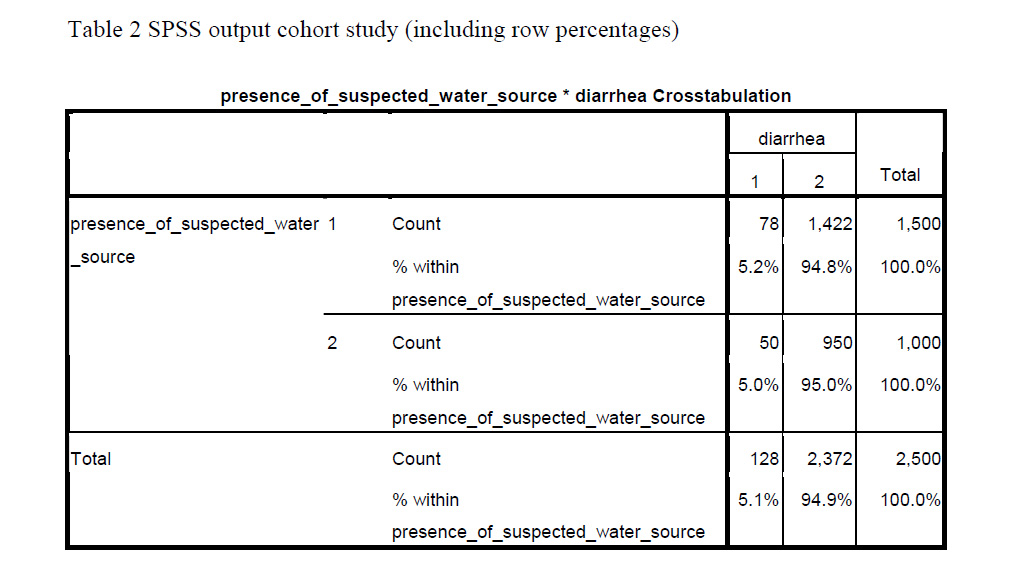Can You Calculate Prevalence In A Case-control Study
by Annette Gerritsen, Ph.D.
Cantankerous-tabulation in accomplice studies
Assume you have just done a cohort study. How practice you actually practice the cantankerous-tabulation to summate the cumulative incidence in both groups?
Best is to ever put the effect variable (affliction yep/no) in the columns and the exposure variable in the rows. In other words, put the dependent variable–the 1 that describes the problem under report–in the columns. And put the independent variable– the factor assumed to cause the problem–in the rows.
Let'due south accept as example a accomplice report used to see whether there is a causal relationship between the apply of a certain h2o source and the incidence of diarrhea among children under five in a hamlet with different water sources. In this case, the variable diarrhea (yeah/no) should be in the columns. The variable water source (suspected/other) should be in the rows.
SPSS will put the lowest value of the variable in the commencement column or row. So in club to get those with diarrhea in the first column you should characterization 'diarrhea' as 1 and 'no diarrhea' as 2. The aforementioned is true for the exposure variable: characterization the 'suspected water source' as 1 and the 'other water source' every bit ii.
You lot will and then be able to calculate the cumulative incidence (adventure of developing the affliction) amid those with the exposure: a / (a + b) and among those without the exposure: c / (c + d).
In the instance of the diarrhea study (Table ane), yous could calculate the cumulative incidence of diarrhea among those exposed to the suspected water source, which would be (78 / ane,500 =) 5.2%.
You tin can besides do this for those exposed to other h2o sources, which would be (50 / ane,000 =) five.0%.

SPSS tin give you these percentages immediately (in cell 'a' and 'c' respectively), when yous ask to display row percentages in the Cells option (Table 2).

Cross-tabulation in Case-Control Studies
When you accept used a instance-command pattern for the diarrhea written report, the actual cross-tabulation is quite like, only "presence of diarrhea aye/no", is now changed into "cases" and "controls.
Label the cases as i, and the controls as 2. Be aware that row percentages have no meaning in terms of occurrence of disease in instance-control studies. This is because in case-control studies the researcher determines how many patients and how many controls are included.
The ratio between the number of patients and controls (e.thou. 2 : 1 or 4 : one) influences the row percentages. So in a example-control report, the cumulative incidence cannot be calculated.
When having conducted a case-control report, you tin can enquire to display column percentages. That gives y'all the proportion of those exposed to the suspected water source among the cases (in jail cell 'a') and amidst the controls (in jail cell 'b').
Table 3 gives the SPSS output for the same diarrhea study bold that it had a case-control design. Using the data provided, (78 / 128 =) 60.9% of the cases were exposed to the suspected water source, while this was (1,422 / 2,372 =) 59.9% of the controls (asked for cavalcade percentages).

Some other article volition be devoted to measures of association: How do y'all really compare cumulative incidence rates in cohort studies? And what measure of association tin be used in case-control studies?
Almost the Author: With expertise in epidemiology, biostatistics and quantitative research projects, Annette Gerritsen, Ph.D. provides s ervices to her clients focussing on the methodological soundness of each phase of an epidemiological study to ensure getting valid answers to the proposed research questions. She is the founder of Epi Upshot.

Getting Started with SPSS
Karen will introduce you lot to how SPSS is prepare up, some hidden features to make information technology easier to use, and some practical tips.
Reader Interactions
Delight note that, due to the large number of comments submitted, whatever questions on problems related to a personal study/project volition not be answered. We suggest joining Statistically Speaking, where you have admission to a individual forum and more resources 24/seven.
Can You Calculate Prevalence In A Case-control Study,
Source: https://www.theanalysisfactor.com/cross-tabulation-in-cohort-and-case-control-studies/
Posted by: barnhartvishadep.blogspot.com


0 Response to "Can You Calculate Prevalence In A Case-control Study"
Post a Comment